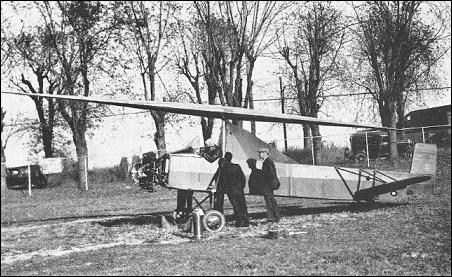The Kellett Brothers, Wallace and Rod, became interested in autogiros and obtained a license under the Autogiro Company of America.
Wallace had been a World War I aviator and after the war had sold French-built Farman airplanes in the United States.
Rather than use the proven Cierva or Pitcairn designs, they went their own way. Their entry was described by Kellett's Engineering Report No.8 as an "extremely light, single-place experimental autogiro." It was designated the K1-X. The airframe was designed to receive any one of three rotor systems: a two-bladed rigid type, a three-bladed hinged type, or a four-bladed hinged type. The two-bladed type was the only one built. The original design was to use a 8.38m diameter rotor, but the diameter was increased to 9.91m. This required lengthening the fuselage to permit the rotor to clear the vertical tail surfaces when it rotated.
The rotor was of wooden monocoque construction using a Gottingen 449 airfoil faired into a 1.02x0.3m center section. The rotor hub and bearings to permit the rotor to teeter like a seesaw were housed inside the center section.
The fuselage construction was spot welded stainless steel angles. The Budd Company, auto body builders in Philadelphia, who were pioneers in spot welding stainless steel aircraft structures built the fuselage.
The landing gear was made from welded steel tubing. The hydraulic shock struts had an 0.2m travel, using stacked rubber discs for taxiing. The wheels were equipped with 18x3 high pressure tires.
The wings were actually tail surfaces. All were of wood construction.
The entire autogiro except the rotor was covered with airplane fabric and doped.
The original powerplant was a Szekley (pronounced Zay-Kay) three cylinder, air cooled, radial engine giving 40hp at 1800 rpm. This was changed during testing to a five cylinder, air-cooled Velie M-5 radial engine giving 65hp at 1900 rpm. The propeller for the Szekley was 1.83m in diameter. There is no record of the diameter propeller used on the Velie, but it is assumed to be the same diameter.
Tests began October 14, 1930, apparently at Philadelphia Municipal Airport, on October 15. The K1-X was moved to Pitcairn Field. Larger wheels from Pitcairn's Cierva C-19 were installed and the tail skid shortened 2.5-1.2cm to increase the ground angle. The RH landing gear failed on the first run with these wheels. Reports show tests were discontinued on December 3, 1930. In spite of the fact that the 65hp Velie was installed early in November 1930, the K1-X never left the ground.
There was no means provided to spin the rotor up mechanically so all attempts to take off had to be made by taxiing faster and faster to build up rotor RPM. One straight run could not be made. Rpm was lost each time on turns and down wind runs. The final test report says, "Air speed 93km/h rotor 150 rpm � no tendency to take off. Broke tailskid. Tests discontinued".
G.Townson "Autogiro. The Story of the Windmill Plane", 1985





